Kentucky Derby
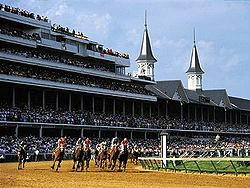
African American Jockey Aims for Derby History
Jockey Kevin Krigger is set to become only the second African American jockey to ride in the Kentucky Derby since 1921. He hopes to be the first African American jockey to win the race since 1902. The Kentucky Derby is Saturday.
(pron.: /ˈdɜrbi/) is a Grade I stakes race for three-year-old Thoroughbreds, held annually in Louisville, Kentucky, United States, on the first Saturday in May, capping the two-week-long Kentucky Derby Festival. The race is one and a quarter miles (2 km) at Churchill Downs. Colts and geldings carry 126 pounds (57 kilograms) and fillies 121 pounds (55 kilograms). The race is known in the United States as “The Most Exciting Two Minutes In Sports” or “The Fastest Two Minutes in Sports” for its approximate duration, and is also called “The Run for the Roses” for the blanket of roses draped over the winner. It is the first leg of the US Triple Crown and is followed by the Preakness Stakes, then the Belmont Stakes. Unlike the Preakness and Belmont Stakes, which took hiatuses in 1891-1893 and 1911-1912 respectively, the Kentucky Derby has been run every consecutive year since 1875. A horse must win all three races to win the Triple Crown. The attendance at the Kentucky Derby ranks first in North America and usually surpasses the attendance of all other stakes races including the Preakness Stakes, Belmont Stakes and the Breeders’ Cup.
History
In 1882, Col. Meriwether Lewis Clark, Jr., grandson of William Clark of theLewis and Clark expedition, traveled to England, visiting the Derby, a famous race that had been running annually since 1780. From there, Clark went on to Paris, France, where in 1863, a group of racing enthusiasts had formed the French Jockey Club and had organized the Longchamps, which at the time was the greatest race in France.
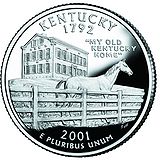 A thoroughbred horse is depicted on the reverse of the Kentucky state quarter
A thoroughbred horse is depicted on the reverse of the Kentucky state quarter
Returning home to Kentucky, Clark organized the Louisville Jockey Club for the purpose of raising money to build quality racing facilities just outside of the city. The track would soon become known as Churchill Downs, named for John and Henry Churchill, who provided the land for the racetrack. Officially, the racetrack was incorporated as Churchill Downs in 1937.
The Kentucky Derby was first run at 11⁄2 miles (2.4 kilometres), the same distance as the Epsom Derby. In 1896, the distance was changed to its current 11⁄4 miles (2.0 kilometres). On May 17, 1875, in front of an estimated crowd of 10,000 people, a field of 15 three-year-old horses contested the rainbow first Derby. Under jockey Oliver Lewis, a colt named Aristides, who was trained by future Hall of Famer Ansel Williamson, won the inaugural Derby. Later that year, Lewis rode Aristides to a second-place finish in the Belmont Stakes.
Although the first race meet proved a success, the track ran into financial difficulties and in 1894 the New Louisville Jockey Club was incorporated with new capitalization and improved facilities. Despite this, the business floundered until 1902 when Col. Matt Winn of Louisville put together a syndicate of businessmen to acquire the facility. Under Winn, Churchill Downs prospered and the Kentucky Derby then became the preeminent stakes race for three-year-old thoroughbred horses in North America.
Between 1875 and 1902, African-American jockeys won 15 of the 28 runnings of the Kentucky Derby. On May 11, 1892, African-American jockey Alonzo “Lonnie” Clayton, age 15, became the youngest rider to win the Derby. The 1904 race was won by Elwood, the first Derby starter and winner owned by a woman, Laska Durnell. In 1915, Regret became the first filly to win the Kentucky Derby (of only three in the history of the race), and in 1917, the English-bred colt “Omar Khayyam” became the first foreign-bred horse to win the race.
Derby participants are limited to three-year-old horses. No horse since Apollo in 1882 has won the Derby without having raced at age two.
Thoroughbred owners began sending their successful Derby horses to compete a few weeks later in the Preakness Stakes at the Pimlico Race Course, in Baltimore, Maryland, followed by the Belmont Stakes in Elmont, New York. The three races offered the largest purse and in 1919 Sir Barton became the first horse to win all three races. However, the term Triple Crown didn’t come into use for another eleven years. In 1930, when Gallant Fox became the second horse to win all three races, sportswriter Charles Hatton brought the phrase into American usage. Fueled by the media, public interest in the possibility of a “superhorse” that could win the Triple Crown began in the weeks leading up to the derby. Two years after the term was coined, the race, which had been run in mid-May since inception, was changed to the first Saturday in May to allow for a specific schedule for the Triple Crown races. Since 1931, the order of Triple Crown races has been the Kentucky Derby first, followed by the Preakness Stakes and then the Belmont Stakes. Prior to 1931, eleven times the Preakness was run before the Derby. On May 12, 1917 and again on May 13, 1922, the Preakness and the Derby were run on the same day. On eleven occasions the Belmont Stakes was run before the Preakness Stakes.
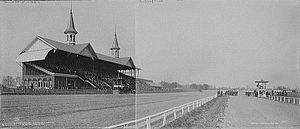 Churchill Downs in 1901
Churchill Downs in 1901
On May 16, 1925, the first live radio broadcast of the Kentucky Derby was originated by WHAS and was also carried by WGN in Chicago. On May 3, 1952, the first national television coverage of the Kentucky Derby took place, aired from then- CBS affiliate WHAS-TV. In 1954, the purse exceeded $100,000 for the first time. In 1968 Dancer’s Image became the first (and to this day the only) horse to win the race and then be disqualified after traces of phenylbutazone, an analgesic and anti-inflammatory drug, were found in the horse’s urinalysis; Forward Pass won after a protracted legal battle by the owners of Dancer’s Image (which they lost). Forward Pass thus became the Eighth winner for Calumet Farm. Unexpectedly, the regulations at Kentucky thoroughbred race tracks were changed some years later, allowing horses to run on phenylbutazone. In 1970 Diane Crump became the first female jockey to ride in the Derby, finishing 15th aboard Fathom.
The fastest time ever run in the Derby (at its present distance) was set in 1973 at 1 minute 59 2/5 seconds when Secretariatbroke the record set by Northern Dancer in 1964. Not only has Secretariat’s record time stood for 39 years and counting, but in the race itself, he did something unique in Triple Crown races: each successive quarter, his times were faster. Though times for non-winners were not recorded, in 1973 Sham finished second, two and a half lengths behind Secretariat in the same race. Using the thoroughbred racing convention of one length equaling one-fifth of a second to calculate Sham’s time, he also finished in under two minutes. Another sub-two-minute finish, only the third, was set in 2001 by Monarchos at 1:59.97.
The 2004 Derby marked the first time that jockeys, as a result of a court order, were allowed to wear corporate advertising logos on their clothing.
In 2005, the purse distribution for the Derby was changed, so that horses finishing fifth would henceforth receive a share of the purse; previously only the first four finishers did so.
Norman Adams has been the designer of the Kentucky Derby Logo since 2002. On February 1, 2006, the Louisville-based fast-food company Yum! Brands, Inc. announced a corporate sponsorship deal to call the race “The Kentucky Derby presented by Yum! Brands.”
In 2007, HM Queen Elizabeth II, on a visit to the United States, joined the racegoers at Churchill Downs.
In 2010 Calvin Borel set a new record, being the first jockey to win 3 out of 4 consecutive Kentucky Derbys.
Traditions
In addition to the race itself, a number of traditions play a large role in the Derby atmosphere. The mint julep, an iced drink consisting of bourbon, mint and a sugar syrup, is the traditional beverage of the race. The historic drink can be served in an ice-frosted silver julep cup, but most Churchill Downs patrons sip theirs from souvenir glasses (first offered in 1939 and available in revised form each year since) printed with all previous Derby winners. Also, burgoo, a thick stew of beef, chicken, pork and vegetables, is a popular Kentucky dish served at the Derby.
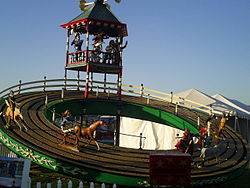 Louisville Clock (often called the Louisville Derby Clock)
Louisville Clock (often called the Louisville Derby Clock)
The infield, a spectator area inside the track, offers general admission prices but little chance of seeing much of the race. Instead, revelers show up in the infield to party with abandon. By contrast, “Millionaire’s Row” refers to the expensive box seats that attract the rich, the famous and the well-connected. Women appear in fine outfits lavishly accessorized with large, elaborate hats. As the horses are paraded before the grandstands, the University of Louisville Marching Band plays Stephen Foster‘s “My Old Kentucky Home,” a tradition which began in 1921.
The Derby is frequently referred to as “The Run for the Roses,” because a lush blanket of 564 red roses is awarded to the Kentucky Derby winner each year. The tradition originated in 1883 when New York socialite E. Berry Wall presented roses to ladies at a post-Derby party that was attended by Churchill Downs founder and president, Col. M. Lewis Clark. This gesture is believed to have led Clark to the idea of making the rose the race’s official flower. However, it was not until 1896 that any recorded account referred to roses being draped on the Derby winner. The Governor of Kentucky awards the garland and the trophy. Pop vocalist Dan Fogelberg composed the song “Run for the Roses” which was released in time for the 1982 running of the race.
 A brief history of black jockeys in the United States –Teresa Genaro, Contributor, SPORTSMONEY, Forbes May 4, 2013
A brief history of black jockeys in the United States –Teresa Genaro, Contributor, SPORTSMONEY, Forbes May 4, 2013
“The sport of horse racing is the only instance where the participation of blacks stopped almost completely while the sport itself continued—a sad commentary on American life…Isaac Murphy, so highly admired during his time for his skills and character, would have been ashamed of his sport. –Arthur Ashe, quoted by Edward Hotaling in They’re Off! Horse Racing at Saratoga”
Isaac Murphy was the first jockey to win the Kentucky Derby three times, and he was the first black jockey to be inducted in the Thoroughbred racing Hall of Fame, in 1955. Oliver Lewis, the winning jockey in the first Kentucky Derby, in 1875, was African-American, one of 13 black jockeys in a 15-horse race that year. Black jockeys won 15 of the first 28 Kentucky Derbies.
But at any race track in this country now, you’d have a hard time finding an African-American in the saddle.
In the early days of racing in this country, African-American faces were prominent. Slaves in the south grew up on farms, working in stables, and plantation owners wouldn’t hesitate to put their slaves on their horses’ backs in informal racing in the south. When racing became organized sport in the early 19th century, black boys and men were in the vanguard in the saddle, dominating racing until the turn of the century.
But as was the case with so many other segments of American life, racism pushed black jockeys out of the saddle – literally and figuratively – and by the early part of the 20th century, they had virtually disappeared from horses’ backs at America’s biggest racetracks.
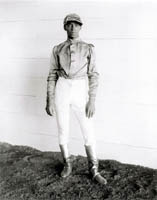 From the National Museum of Racing and Hall of Fame
From the National Museum of Racing and Hall of Fame
Jimmy Winkfield was a black jockey who rose to national prominence with his riding skills; he won the Kentucky Derby in 1901 and 1902, the first jockey to win America’s most famous race back to back, and one of only five to ever accomplish that feat. But even he was not immune to the social forces that worked to marginalize African-Americans’ role in racing.
Winkfield got his start in Kentucky, but in 1900, he came to New York to try his hand here, at the nation’s most prestigious tracks. The experiment didn’t last long.
As Joe Drape details in Black Maestro, his biography of Winkfield, the jockey’s skill was secondary to the color of his skin:
“An Anti-Colored Union was in place, with the goal of running the black riders off the racetrack. It had begun earlier in the year at the Queens County track when the white jockeys…put the word out that if owners wanted to take home first-place purses, they’d best not ride the colored jockeys…Sometimes [the white jockeys] pocketed, or surrounded, a black jockey until they could ride him into and over the rail. Their whips found the thighs, hands, and face of the colored boy next to them more often than the horse they were riding. Every day a black rider ended up in the dirt; and every day racing officials looked the other way.”
According to Drape, Winkfield only lasted a couple of weeks in New York. And within four years, he left the United States for Europe, where he became a celebrity on and off the track, marrying into Russian aristocracy. His influence on American racing ended in 1904, the year that he left this country. He was 22 years old.
In 2004, Winkfield was inducted into the Racing Hall of Fame, and the following year, the New York Racing Association named a race in his honor, run each year on the Martin Luther King, Jr. holiday. In December 2004, NPR’s Tavis Smiley talked to John Lee, at the time director of broadcasting at NYRA, about the decision to name a race after Winkfield.



